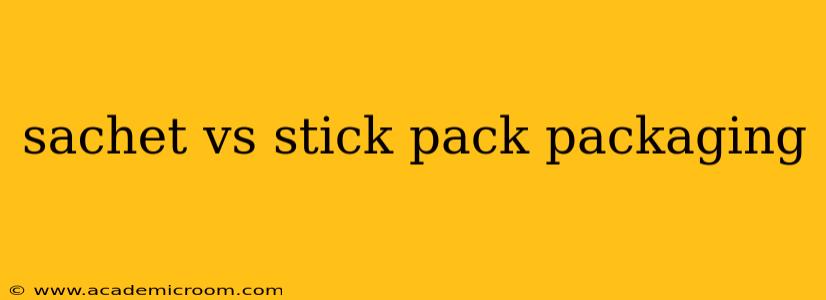Choosing the right packaging for your product can significantly impact its success. For single-serving or small-portion products, sachet and stick pack packaging are popular choices, each offering unique advantages and disadvantages. This comprehensive guide will delve into the key differences between sachet and stick pack packaging, helping you determine which option best suits your needs.
What is Sachet Packaging?
Sachet packaging is a flexible, usually foil-based, pouch typically sealed on three sides, leaving one open end for easy dispensing. They are widely used for a variety of products, from condiments and spices to cosmetics and pharmaceuticals. Sachets are often made from materials like aluminum foil, plastic film (like polyethylene or polypropylene), or a combination of both, offering good barrier properties to protect the product's contents from moisture, oxygen, and light.
What is Stick Pack Packaging?
Stick packs, also known as single-serve packets or pillow packs, are similar to sachets but are characterized by their distinct rectangular shape and often have a peelable or tearable opening. They are commonly used for powdered products like sugar, coffee, or supplements, but also see use in liquid and paste formats. Stick packs typically utilize materials designed for easy dispensing and are often made from multiple layers of film to provide a barrier against external elements.
Sachet vs. Stick Pack: Key Differences
While both are used for single-serve packaging, several key differences distinguish sachets and stick packs:
Shape and Size:
- Sachets: More varied in shape, often including a wider, flatter design. Sizes are generally flexible but often larger than stick packs.
- Stick Packs: Consistently rectangular or square, resembling a small stick. They tend to be narrower and taller than sachets.
Material:
- Sachets: Can be made from various materials including aluminum foil, plastic films, or laminated structures. This offers flexibility in barrier properties, catering to different product needs.
- Stick Packs: Commonly utilize multiple layers of plastic films, often with heat-sealable properties for a secure closure and easy opening.
Opening Mechanism:
- Sachets: Usually opened by tearing or cutting at the open end. This may require scissors or a sharp edge.
- Stick Packs: Typically feature a peelable or tearable notch for easy opening without tools.
Manufacturing Process:
- Sachets: Typically use a more straightforward filling and sealing process.
- Stick Packs: Often involve more complex and specialized machinery.
Cost:
- Sachets: Generally less expensive to produce than stick packs.
- Stick Packs: Due to more complex machinery and materials, usually have a higher production cost.
Applications:
- Sachets: Widely used for a variety of products, including condiments, spices, tea bags, cosmetics samples, and pharmaceutical drugs.
- Stick Packs: Commonly used for powdered products such as coffee, sugar, supplements, and powdered drinks; they also accommodate liquids and pastes increasingly.
Which Packaging is Best for My Product?
The optimal choice between sachet and stick pack packaging depends on several factors:
- Product type: Powders, liquids, and pastes can all be accommodated by both, but stick packs often offer better functionality for certain types of powders.
- Product properties: Fragile products might benefit from the stronger barrier offered by certain sachet materials. Products sensitive to moisture and oxygen require high-barrier films.
- Target audience: Consider the convenience and ease of use factors for your customers. Stick packs’ easy-opening features are generally preferred by consumers.
- Budget: Sachets are often a more budget-friendly option compared to stick packs.
- Brand image: The shape and design of the packaging influence brand perception.
Frequently Asked Questions
What are the benefits of using sachet packaging?
Sachet packaging offers cost-effectiveness, good barrier protection, and versatility for various product types. They are suitable for both liquid and powdered products.
What are the advantages of using stick pack packaging?
Stick packs provide excellent convenience and portion control. Their easy-opening features enhance user experience and contribute to a cleaner dispensing.
Are stick packs more hygienic than sachets?
Generally, stick packs offer improved hygiene due to their sealed nature and the absence of the need for scissors or sharp objects to open them. However, proper handling and storage are crucial for both types of packaging to maintain hygiene.
Which packaging is better for environmental sustainability?
Both sachet and stick pack packaging can be made from recyclable materials, and selecting environmentally friendly options is crucial for sustainability. However, the choice may depend on the specific materials and manufacturing processes used.
What is the shelf life of products in sachet and stick pack packaging?
Shelf life depends heavily on the product itself, the packaging materials used (barrier properties against moisture, oxygen, and light), and proper storage conditions. High-barrier materials extend shelf life in both sachet and stick pack options.
By carefully considering these factors, you can make an informed decision about the most suitable packaging for your product, maximizing its appeal to consumers and ensuring its success in the marketplace. Remember to always prioritize consumer experience and product protection when selecting your packaging solution.
